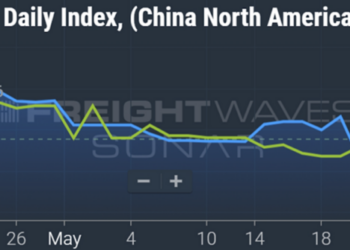The average price of diesel at the pump is showing nothing but down arrows, according to the report of the Department of Energy/Energy Information Administration (DOE/EIA) average weekly retail price.
The price used for most fuel surcharges was posted Monday at $4.209 a gallon. That is down 8.5 cents in the past week and 38.4 cents since a recent high on Oct. 2. It’s also down 33.6 cents per gallon in the past four weeks, the current streak of declines, and in the past year, it’s down $1.024 a gallon.
Retail prices, as usual, are catching up to earlier declines in the futures market, which then are generally quickly reflected in wholesale markets.
From a settlement of $3.1767 a gallon on Oct. 17, the price of ultra low sulfur diesel (ULSD) on the CME commodity exchange plummeted to a recent low settlement of $2.7191 a gallon on Nov. 9.
It moved up and down over the next several days. But then after settling Thursday at $2.7502 a gallon Thursday, ULSD moved up the next two days, settling Monday at $2.8495 a gallon, an increase of almost 10 cents since the Thursday settlement.
The upward movement the past two trading days is generally believed to be driven by the possibility of more output cuts coming from a meeting Sunday of leading oil producers.
OPEC+, a large group of oil exporters that includes the members of OPEC as well as some non-OPEC countries led by Russia, will meet that day. There have been two significant cuts by the members of the group earlier this year: an OPEC+-wide reduction in April that totaled about 1.16 million barrels a day and then a further reduction by Saudi Arabia alone of 1 million barrels a day that began in July.
Markets have been pushed higher by speculation that given the supply/demand balance in the global oil market that has pushed global benchmark Brent down below $80 a barrel at times — far from any sort of unofficial $100-per-barrel target — Saudi Arabia might not only extend its reduction into 2024, which is expected, but might cut further.
The march to $100-per-barrel Brent, which got up above $95 a barrel by the end of September, has been thwarted mostly by higher crude output from some of the OPEC+ members, such as Iran, as well as higher production in several other nations, like the U.S., Brazil and Guyana.
Demand, meanwhile, is healthy. In its latest monthly report, the International Energy Agency said global demand in 2023 would be 102 million barrels a day, an increase of 2.4 million barrels per day. That figure was an increase of 110,000 barrels a day more than its estimate in the October report. But when it comes to the price of oil, the supply gains appear to be negating that increase in demand.
One factor that has not yet been able to boost oil prices is tight inventories, particularly in diesel. The latest weekly report of the EIA on ULSD inventories, for the week ended Nov. 10, showed them to be about 86% of the seven-year average for the second week of November.
But that isn’t necessarily the case everywhere. Argus Media last week reported that middle distillate inventories in the refining and storage hub of Singapore were recently at a two-year high.
In an interview Monday on CNBC, Amrita Sen, the director of research at the Energy Aspects consultancy, said movements in inventories are also impacting markets. “Right now, with higher interest rates, nobody wants to hold any inventory,” Sen said. “So I think we’ve seen more destocking as well.”
The destocking is bearish because it is putting more supply on the market or eliminating demand that might otherwise go to build up stocks. But the tight inventories themselves then become a bullish factor.
More articles by John Kingston
STB’s Oberman rips into Union Pacific CEO Vena
Estes execs recap hack experience in unusual video presentation
3PLs get fresh legal win in fight to block liability in truck accidents
The post Another decline in average diesel pump prices; OPEC+ meeting looms appeared first on FreightWaves.














